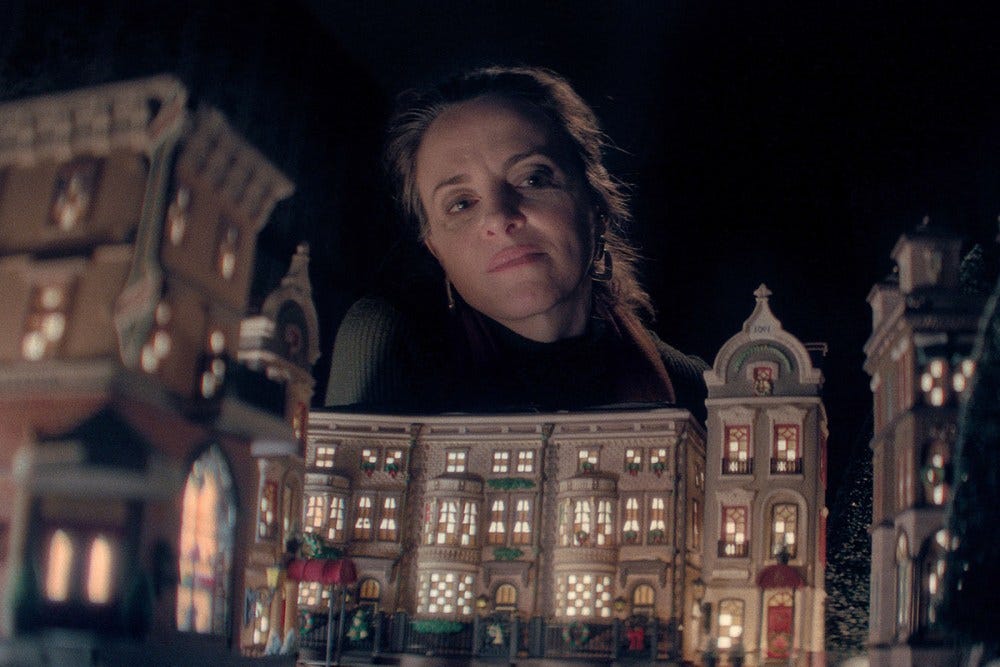Each of Tyler Taormina’s first three features indulges in woozy suburban fantasy. With a sensibility that straddles genre and arthouse cinemas, he creates elastic films founded on the knowledge that these provincial oases, not without their fair share of alienation, are of a bygone era, eroded by the atomizing effect of 21st century technology. Ham on Rye, his funky, psychedelic debut, revolves around a sandwich shop that plays a pivotal role in the neighborhood prom before jumping ten years later, following the now-adults as they loiter the neighborhood’s backlots and strip malls. Happer’s Comet, a Covid-era riff on Akerman’s Toute Une Nuit, is a wordless series of vignettes all taking place during a single night, a tone poem of the comfort and melancholy of the suburbs. With Christmas Eve in Miller’s Point, Taormina combines the strengths of his two previous efforts (the semi-ironic, maximalist rendition of suburban childhood, and the evocation of lonely nocturnal intimacy), with a subject that matches his virtuosic approach: a picture perfect Christmas gathering.
Unfolding as a jukebox musical in the vein of Terence Davies’ early autobiographical films, Miller’s Point takes place over the Miller family Christmas Eve party. With its endless accompaniment of mid-century songs and an opening sequence that turns passing Christmas lights into a blinking multicolored mosaic, Taormina immediately dispenses with reality, introducing us to the family in disorienting, but unmistakably festive terms.
The first hour or so of the film, which is confined to the party, is a masterclass in bravura filmmaking. Roving the family house, dipping in and out of poetic moments, Taormina modulates the tone somewhere between ecstasy and horror, creating an insular world that’s as classically celebratory as it is obviously unreal. The clearest ambiguity is the film’s unstable temporality, with characters using flip phones and landlines while a Roomba (outfitted with a cutout model taped to the top to give the impression of a hovering lady) whirs in the background, but the film also features a shot of a young girl putting on a pair of glasses that turns the world into a field of prismatic refractions, a handy metaphor for the film’s child-like perspective. The highlight of this early stretch is a tradition where the fire department outfits their trucks in Christmas lights and drives through the streets. After the neighborhood congregates and waits for the procession of trucks with bated breath, Taormina shoots the firefighters as an extended impressionistic sweep (think Chungking Express). It’s so magnificent that it makes the ungodly screams from the children seem like the only natural response.
Eventually, loose emotional threads emerge. The health of the family matriarch is failing, and by this time next year the house may be sold. Unbeknownst to the children, this may be their last Christmas together.
In the second half of Miller’s Point, Taormina separates the children from their parents. The parents have a funereal night drinking and talking, silently grappling with the family’s uncertain future. In a particularly moving moment, Taormina recreates a shot from Yi Yi, a tender seance between mother and daughter that portends the outcome of Christmas Eve. Meanwhile, the children sneak out and meet up with their friends at a bagel joint to engage in a night of teenage revelry. With the offbeat quirk of Ham on Rye’s sandwich shop scenes (for example, the entire bagel joint goes quiet whenever the door opens), the children’s nocturnal journey through town confronts them with the transience of childhood. Their travails bring them into contact with three lonely stoners, haunting the neighborhood since their high school graduation ten years ago, and two bumbling cops, one of whom is played by Michael Cera (placing Miller’s Point in conversation with the anti-nostalgia of Twin Peaks: The Return). For every moment of melancholy, Taormina counterpoints with a beautiful moment of offhand poetry, such as love at first sight filtered through the reflection of a perfectly-frosted window.
Wandering through a studio-bound enchanted forest, the children slowly recognize that they’re living through the end of something. As one of the girls looks up at the snowfall, she’s met with the anxious downward gaze of her mother. When the sun rises and she wanders home, she knows that everything has changed.
Christmas Eve In Miller’s Point is distributed by IFC Films and is in theaters now.





